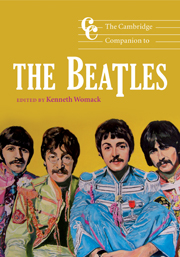Book contents
- Frontmatter
- Introducing the Beatles
- Part I Background
- Part II Works
- 3 Rock and roll music
- 4 “Try thinking more”: Rubber Soul and the Beatles' transformation of pop
- 5 Magical mystery tours, and other trips: yellow submarines, newspaper taxis, and the Beatles' psychedelic years
- 6 Revolution
- 7 On their way home: the Beatles in 1969 and 1970
- 8 Apple Records
- 9 The solo years
- 10 Any time at all: the Beatles' free phrase rhythms
- Part III History and influence
- Notes
- Beatles discography, 1962–1970
- Select bibliography
- Index
10 - Any time at all: the Beatles' free phrase rhythms
from Part II - Works
Published online by Cambridge University Press: 28 September 2011
- Frontmatter
- Introducing the Beatles
- Part I Background
- Part II Works
- 3 Rock and roll music
- 4 “Try thinking more”: Rubber Soul and the Beatles' transformation of pop
- 5 Magical mystery tours, and other trips: yellow submarines, newspaper taxis, and the Beatles' psychedelic years
- 6 Revolution
- 7 On their way home: the Beatles in 1969 and 1970
- 8 Apple Records
- 9 The solo years
- 10 Any time at all: the Beatles' free phrase rhythms
- Part III History and influence
- Notes
- Beatles discography, 1962–1970
- Select bibliography
- Index
Summary
A number of those interested in the music of the Beatles have singled out for discussion its rhythmic inventiveness. Most discussions of the Beatles' rhythmic devices start and end with an appreciation of their remarkably wide-ranging approaches to the metric surface, paying particular attention to asymmetrical meters (those representing measures containing numbers of beats not divisible by two or three, as in the 5/4 meter appearing in “Within You Without You” [SP]) or the many examples of freely mixed meter (as with the repeated alternation of 4/4 and 3/4 bars in “All You Need is Love” [MMT]). Another interesting development in the Beatles' rhythmic invention is their flexibility with strongly accented patterns of syncopation, which arises when normally weak beats or weak parts of beats (such as the second and fourth beats in 4/4 meter, or the second eighth within a quarter-note beat) are accented by strong melodic events (as with a sudden high note), rhythmically unexpected chord changes (normally changing on downbeats but subject to expressive versatility), or obtrusive dynamics (as with the normal rock drumbeat pattern, which loudly accents the snare on beats two and four). Because these and other related effects are manifest for the most part at the beat level (between the barlines), they are all relatively superficial and may be accounted for chiefly in the musical foreground (as opposed to groupings of measures and of phrases, which may be thought to occupy progressively deeper middle-ground and background orientations).
- Type
- Chapter
- Information
- The Cambridge Companion to the Beatles , pp. 183 - 200Publisher: Cambridge University PressPrint publication year: 2009
- 5
- Cited by



